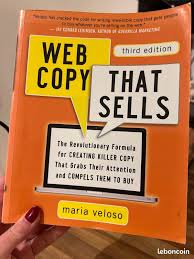Abstract: This white paper explores the intersection of classic copywriting principles, as exemplified in "The Boron Letters," modern copywriting frameworks like WeCopyThat Sells, and the evolving landscape of web content strategy. It aims to provide a comprehensive guide to creating effective, engaging, and persuasive online content that drives conversions.
The Boron Letters, WeCopyThat Sells, and Copywriting Handbooks: A Comprehensive White Paper on Web Content Strategy
Abstract: This white paper explores the intersection of classic copywriting principles, as exemplified in "The Boron Letters," modern copywriting frameworks like WeCopyThat Sells, and the evolving landscape of web content strategy. It aims to provide a comprehensive guide to creating effective, engaging, and persuasive online content that drives conversions.
1. Introduction
In today's digital age, compelling web content is essential for businesses to attract, engage, and convert their target audience. While the mediums may have changed, the fundamental principles of persuasive writing, as outlined in legendary texts like Gary Halbert's "The Boron Letters," remain highly relevant. This white paper will delve into these timeless principles, examine contemporary copywriting frameworks, and provide actionable insights for crafting a winning web content strategy.
2. The Boron Letters: Timeless Wisdom for the Digital Age
"The Boron Letters," a collection of personal letters written by Gary Halbert to his son, offer invaluable lessons in copywriting and marketing. Though penned in the 1980s, the principles espoused in these letters remain remarkably relevant today. Some key takeaways include:
- Understanding your audience: Halbert emphasizes the importance of deeply understanding your target audience's desires, fears, and motivations. This principle is crucial for crafting web content that resonates with readers and compels them to take action.
- Writing with clarity and conciseness: Halbert champions clear, concise writing that is easy to understand and avoids jargon. This is particularly important for web content, where readers have short attention spans and are quick to abandon convoluted text.
- Building strong headlines and leads: Halbert stresses the significance of captivating headlines and engaging leads that hook the reader's attention. In the digital realm, where content competes for attention, compelling headlines and leads are more crucial than ever.
- Creating a sense of urgency: Halbert advocates for instilling a sense of urgency in your writing to encourage immediate action. This can be effectively applied to web content through limited-time offers, countdown timers, and compelling calls to action.
- Focusing on benefits over features: Halbert emphasizes highlighting the benefits of your product or service rather than simply listing its features. This principle is particularly relevant for web content, where readers are looking for solutions to their problems.
3. WeCopyThat Sells: A Modern Copywriting Framework
WeCopyThat Sells, a popular copywriting framework developed by John Forde, provides a structured approach to crafting high-converting copy. This framework, while building on classic copywriting principles, offers a contemporary perspective tailored to the digital landscape. Some key elements of the WeCopyThat Sells framework include:
- The "Big Idea": This refers to the core message or unique selling proposition that differentiates your product or service. A strong Big Idea is crucial for creating web content that stands out from the competition.
- The "Story": This involves crafting a compelling narrative that connects with the reader on an emotional level. Storytelling is a powerful tool for engaging audiences and building brand loyalty.
- The "Offer": This encompasses the specific value proposition you are presenting to the reader. A clear and compelling offer is essential for driving conversions.
- The "Guarantee": This provides a sense of security and trust to the reader by minimizing their risk. Guarantees can significantly increase conversion rates.
4. Web Content Strategy: A Holistic Approach
Effective web content strategy goes beyond simply writing good copy. It involves a holistic approach that encompasses various elements, including:
- Content planning and creation: This involves identifying your target audience, defining your content goals, and creating a content calendar.
- Search engine optimization (SEO): This involves optimizing your content for search engines to improve your website's visibility and organic traffic.
- Content promotion and distribution: This involves promoting your content through various channels, such as social media, email marketing, and paid advertising.
- Content analysis and optimization: This involves tracking your content's performance and making data-driven adjustments to improve its effectiveness.
5. Integrating Copywriting Principles into Web Content Strategy
To create a winning web content strategy, it's essential to integrate the principles of classic copywriting and modern frameworks like WeCopyThat Sells into your overall approach. This includes:
- Crafting compelling headlines and meta descriptions: Use strong headlines and meta descriptions that accurately reflect your content and entice users to click.
- Writing engaging and informative body content: Provide valuable information that addresses your audience's needs and interests.
- Using clear and concise language: Avoid jargon and technical terms that your audience may not understand.
- Incorporating strong calls to action: Encourage users to take the desired action, whether it's making a purchase, signing up for a newsletter, or sharing your content.
- Optimizing your content for readability: Use formatting elements, such as headings, subheadings, bullet points, and images, to make your content easy to scan and digest.
- Ensuring your content is mobile-friendly: With the increasing use of mobile devices, it's crucial to ensure your content is easily accessible and readable on all screen sizes.
6. Conclusion
By integrating the timeless wisdom of "The Boron Letters," the structured approach of WeCopyThat Sells, and a comprehensive web content strategy, businesses can create compelling online content that drives conversions and achieves their marketing goals. While the digital landscape continues to evolve, the fundamental principles of persuasive writing remain steadfast, providing a solid foundation for crafting effective web content.
References:
- Halbert, G. (1984). The Boron Letters.
- Maria Veloso (2013). Web Copy That Sells.
- Nielsen, J. (2000). Designing Web Usability: The Practice of Simplicity.
- Handley, A. (2011). Content Rules: How to Create Killer Blogs, Podcasts, Videos, Ebooks, Webinars (and More) That Engage Customers and Ignite Your Business.
